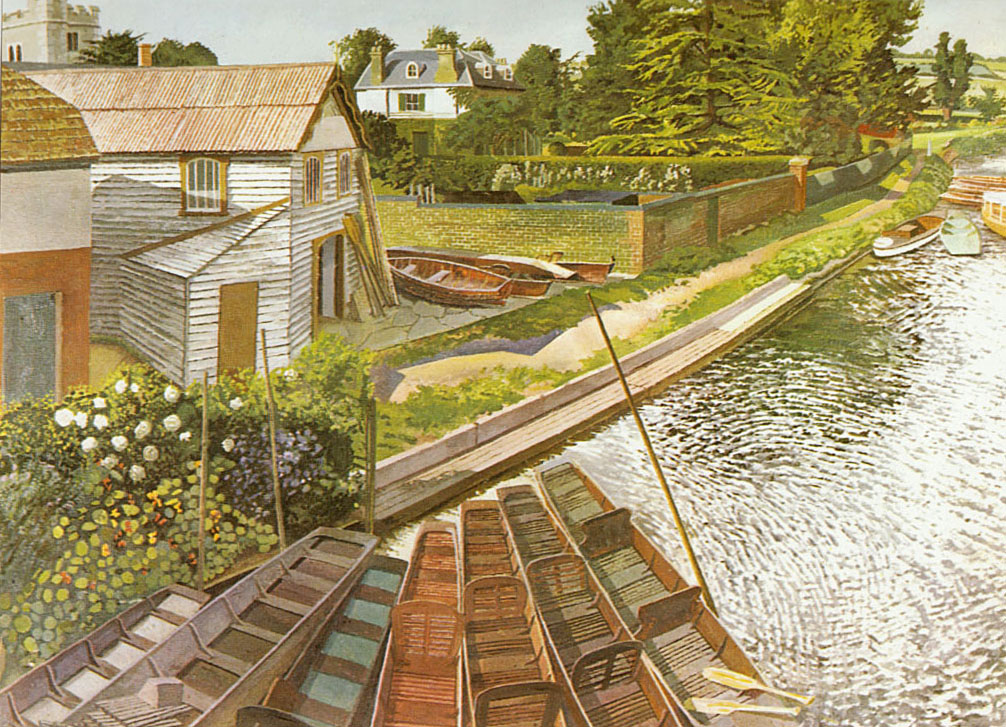 At the Stanley Spencer Gallery in Cookham, the exhibition in the little building is Stanley and the First Mrs Spencer, reflecting the influence of Hilda Carline on his work. I really like the way he interjects religious scenes into everyday compositions, often with particular reference to his local village - or is it the other way round?
At the Stanley Spencer Gallery in Cookham, the exhibition in the little building is Stanley and the First Mrs Spencer, reflecting the influence of Hilda Carline on his work. I really like the way he interjects religious scenes into everyday compositions, often with particular reference to his local village - or is it the other way round?I like The Scarecrow, Cookham (1934). The Royal Academy rejected two of his paintings before accepting this one; his consequent resignation challenged the Academy's attitude to modern art. Spencer painted from what he knew and he said of this scarecrow, 'Left and deserted as it was, it seemed daily to become more a part of its surroundings. In the evening he faded into the gloaming like a Cheshire cat.'
In paintings such as Hilda and I at Burghclere (1955), he aints scenes of domestic harmony - the whole family (including the cat) is highlighted by every detail of pattern and texture. In Domestic Scenes: At the Chest of Drawers (1936) he presents himself as a diminutive man dominated by an exaggeratedly large woman - a recurring theme through his work. His Self Portrait (1923) and Hilda's Portrait of Stanley Spencer in the same year show the same view but demonstrate their quite different techniques.
View from Cookham Bridge (1936) is another favourite of mine, possibly because the quintissential summer view of the riverside of Cookham is full of naturalistic detail: the punts in the foreground; the currents on the river; the boatyards and hedgerows full of flowers; more formal walled gardens and grassy fields in the distance; the belltower of the church peeping over an uneven red roof... It's all so very familiar.
Roy (1907) is a delightful pen-and-ink drawing of a young boy leaning over the back of a pew in the village church of Holy Trinity. Spencer returned to similar motifs after many years, so there is a similar figure in In Church painted in 1958.
Spencer didn't live to complete his final work - Christ Preaching at Cookham Regatta (1952-9). This is a massive canvas and there are pictures of him paiting it while up a stepladder. Christ preaches to the assembled villagers (some wealthier folk in boats, while others picninc on the banks) from a basket chair in the old horse ferry barge. In 1952 Spencer made sixty chalk drawings as the basis of this picture to be transferred to the canvas to create a complex figure study.
 The exhibition notes explain, 'Spencer grew up in the golden age of the Thames Regatta, when the river became not just a route for commerce, but a place of entertainment and leisure. Rowing and other skills, previously the province of paid watermen, became popular pastimes for amateurs. Attracting 10,000 people at its peak, the regatta at Cookham followed an established pattern, with races followed by a concert and fireworks. As in Spencer's Regatta series, fashion dictated that gentlemen wore white strousers, striped flannel coats and straw hats, and ladies elaborate hats and full-length dresses.
The exhibition notes explain, 'Spencer grew up in the golden age of the Thames Regatta, when the river became not just a route for commerce, but a place of entertainment and leisure. Rowing and other skills, previously the province of paid watermen, became popular pastimes for amateurs. Attracting 10,000 people at its peak, the regatta at Cookham followed an established pattern, with races followed by a concert and fireworks. As in Spencer's Regatta series, fashion dictated that gentlemen wore white strousers, striped flannel coats and straw hats, and ladies elaborate hats and full-length dresses.Another of his deservedly famous paintings, The Last Supper (1920) has pride of place on the wall. Christ sits before the wall of the grain bin in a Cookham malt house. It is beautifully simple, illuminated by golden light, and the disciples' outstretched legs and bare feet meet in the middle under the table in an earthy and rustic fashion.
 Far more stylised, Wisteria at Englefield (1954) is full of exquisite, painstaking detail. It apparently took him five weeks to create this stunningly realistic image of chestnut, wisteria and ceanothus both highlighting and obscuring the red brickwork of Englefield House.
Far more stylised, Wisteria at Englefield (1954) is full of exquisite, painstaking detail. It apparently took him five weeks to create this stunningly realistic image of chestnut, wisteria and ceanothus both highlighting and obscuring the red brickwork of Englefield House.The Gallery also includes studies for the Sandham Memorial Chapel at Burghclere. This chapel was built specifically to house Spencer's war paintings - arguably his finest achievement. I particularly like Map Reading, in which an officer consults his orders and map while the men rest during a pause on a route march, and Bedmaking, as seen by Spencer at a hospital ward where he was ent to recover from malaria.
Other paintings in the series include such commonplace activities as filling the tea urns, washing and shaving, eating bread and jam, sorting the laundry, scrubbing the floor, and filling water bottles. The pictures capture the camaraderie and companionship of the men rather than the horrors of war.
Before going home I went for a walk through the village with its intricately tiled roofs, large green and friendly pub, then I strode through through brick alleyways and across fields of wheat and stubble accomapnied overhead by wheeling red kites. Sir Stanley Spencer described Cookham as 'a village in heaven' - indeed, if there are villages in heaven, they look like this.







No comments:
Post a Comment